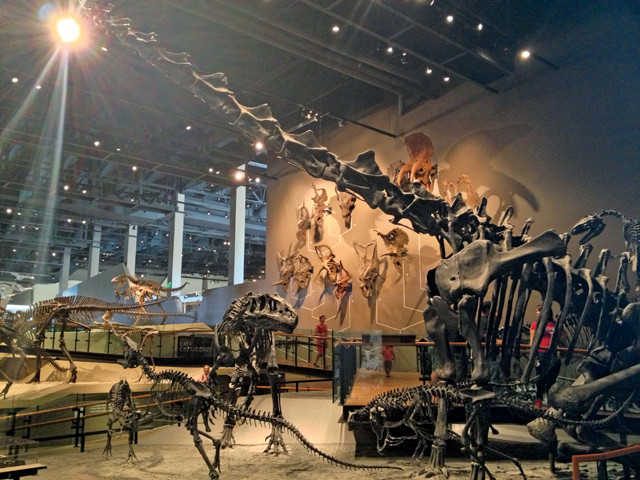
by Lucas Joel Tuesday, August 16, 2016

Dinosaur skeletons fill the halls of the Natural History Museum of Utah in Salt Lake City. Credit: Lucas Joel.
Many studies have sought to track the movements of dinosaurs as they migrated across the supercontinent Pangea before and during its breakup. Now, researchers using a method called “network theory” have shed new light on dinosaur migration patterns.
Alex Dunhill of the University of Leeds in England and co-authors posed the question: Did Pangea’s fragmentation affect dinosaur migration patterns? To answer it, the researchers surveyed the paleontological record to assess the “geographic connectedness” of dinosaur populations and how it changed throughout the Mesozoic.
For example, if the researchers found that the same dinosaur family existed on two separate landmasses within the same time interval, they assumed that genera of that family were migrating between those two regions. This relationship defined a “geographic connection” between the landmasses. The number of connections indicates the strength of the dinosaur “network.”
“One striking pattern is that although Europe shows a high degree of outward connectivity in the Jurassic-Early Cretaceous, there are no inward connections to Europe in the Early-Mid-Jurassic,” Dunhill and his team reported in the Journal of Biogeography.
In other words, dinosaur families were leaving Europe while no new families were arriving on the continent. In a statement, Dunhill explained that this pattern could indicate mass dinosaur migration from Europe, but it could also be “an artifact of the incomplete and sporadic nature of the dinosaur fossil record.”
The researchers also reported that dinosaur geography “was influenced by continental fragmentation and rising [sea levels] throughout the Mesozoic, with fewer … family-level connections occurring in the later Cretaceous than in the Triassic, Jurassic and Early Cretaceous when continents were more closely aligned.”
© 2008-2021. All rights reserved. Any copying, redistribution or retransmission of any of the contents of this service without the expressed written permission of the American Geosciences Institute is expressly prohibited. Click here for all copyright requests.